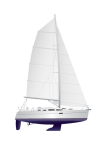Daydream believer
Well-known member
So if he cannot have a straight mast, what can the Op expect of his mast by moving the rig to 5 degrees- A pre bent mast? By how much & does this suit the cut of his sail? If there is no back stay does he lose the ability to provide greater bend prior to first reef for a short while to flatten the sail.A lot of those Hunters are roller reefing main, which implies an additional constraint of a straight mast.
Hence they end up with a lot of rigging.
Even so, it shows the consequences of not having a backstay are not trivial.
Has the OP considered a backstay flicker at the mast head. Very common on some French performance craft up to 30 ft. Some are quite exagerated in their length

